
Minivan is a car classification for vehicles designed to transport passengers in the rear seating row(s), with reconfigurable seats in two or three rows. The equivalent classification in Europe is MPV.

The Unimog is a range of multi-purpose tractors, trucks and lorries that has been produced by Boehringer from 1948 until 1951, and by Daimler Truck since 1951.

The Volkswagen Caddy is a panel van and leisure activity vehicle (M-segment) produced by the German automaker Volkswagen Group since 1980. It is sold in Europe and in other markets around the world. The Volkswagen Caddy was first introduced in North America in 1980 and in Europe in 1982. The first and second generations also had pick-up variants.
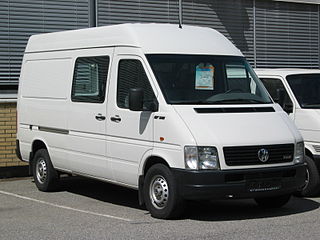
The Volkswagen LT is the largest light commercial panel van produced by Volkswagen from 1975 to 2006, before being replaced by the Crafter. Two generations were produced.
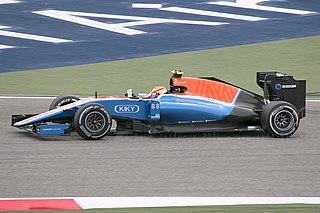
In automotive engineering, a mid-engine layout describes the placement of an automobile engine in front of the rear-wheel axles, but behind the front axle.

The Mercedes-Benz Sprinter is a light commercial vehicle (van) built by Mercedes-Benz Group AG of Stuttgart, Germany as a large van, chassis cab, minibus, and pickup truck. In the past, the Sprinter had been sold under the Mercedes-Benz, Dodge, and Freightliner nameplates. In the U.S., it was built from complete knock down (CKD) kits by Freightliner. Re-badged and re-engined Sprinters were also sold by Volkswagen Commercial Vehicles as the Volkswagen LT and the Volkswagen Crafter. They are now primarily marketed by Mercedes-Benz.

A minibus, microbus, minicoach, or commuter is a passenger-carrying motor vehicle that is designed to carry more people than a multi-purpose vehicle or minivan, but fewer people than a full-size bus. In the United Kingdom, the word "minibus" is used to describe any full-sized passenger-carrying van or panel truck. Minibuses have a seating capacity of between 12 and 30 seats. Larger minibuses may be called midibuses. Minibuses are typically front engine step-in vehicles, although low floor minibuses are particularly common in Japan.
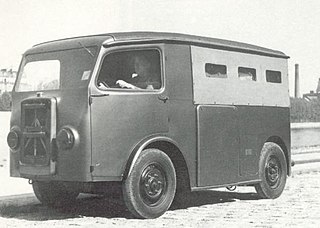
The Citroën TUB was a light van derived from the Traction Avant passenger car. The van was produced by Citroën between 1939 and 1941. In May 1941 an upgraded version, the Citroën TUC replaced the TUB, but by the end of that year the last of these vans had probably been produced.

Opel Blitz was the name given to various light and middleweight trucks built by the German Opel automobile manufacturer between 1930 and 1975. The original logo for this truck, two stripes arranged loosely like a lightning symbol in the form of a horizontally stretched letter "Z", still appears in the current Opel logo. The Blitz name was then applied to the British-made Bedford CF when it replaced the Blitz in certain markets.
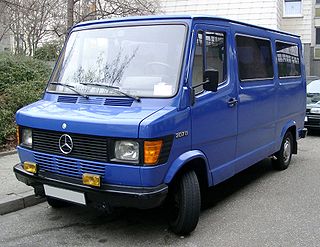
In 1977 Mercedes-Benz introduced a new van/truck, called T1 internally. Other designations were series TN / T1N and Bremer Transporter, since the vehicle was built in the Transporter-Plant in Bremen, Germany, first. In the years 1983/1984 production went - piece by piece - to the Transporter-Plant-Düsseldorf. The internal chassis-designations are: 601, 602 and 611.

The Mercedes-Benz Vito is a mid-sized light commercial vehicle (LCV) produced by Mercedes-Benz, available as a panel van, chassis cab, or multi-purpose vehicle (MPV), carrying cargo or up to eight passengers. In the Mercedes-Benz van lineup, it is positioned between the larger Sprinter and the smaller Citan.

The Borgward Hansa 1500 is a medium-sized automobile manufactured by the Bremen based auto-manufacturer Carl F. W. Borgward GmbH from 1949 until 1954. It was first presented at the Geneva Motor Show in March 1949 and production commenced on 13 October 1949. The similar Hansa 1800 was introduced in 1952. The Hansa was replaced by the Borgward Isabella in 1954.
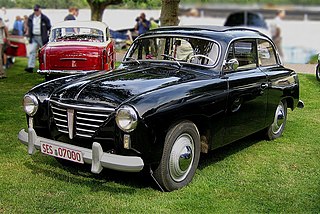
The Goliath GP700 is a small automobile which was manufactured by the Bremen, Germany–based Borgward subsidiary Goliath-Werke Borgward & Co from 1950 to 1957. In 1955, the GP700 was joined by the larger-engined Goliath GP900 E. From 1951 to 1953, a coupé version, the Goliath GP700 Sport was offered. The Goliath was a revolutionary design, which in several important respects pointed the way for automobile development in the second half of the 20th century.

Tempo, was a German automobile manufacturer based in Hamburg. The company was founded by Oscar Vidal in 1924.

The Mercedes-Benz GLA is a subcompact luxury crossover SUV manufactured and marketed by Mercedes-Benz over two generations. It is essentially the SUV equivalent of the A-Class, and the smallest SUV marketed by the brand. The production version was revealed in August 2013 ahead of the 2013 Frankfurt Auto Show in September 2013.

The Mercedes-Benz L 319 is a light commercial vehicle built by Mercedes-Benz between 1955 and 1967. Larger than a standard delivery van, but smaller than a conventional light truck of the period, it was the manufacturer's first model in this class. The vehicle was offered with a range of van and truck bodies. Special application and minibus variants were also available.

The Peugeot DMA was a light truck built by Peugeot between 1941 and 1948. It was the first commercial vehicle from Peugeot to employ a forward control cab, whereby the driver sat right at the front of the vehicle. The configuration maximised load deck length and gave the driver a good view of the road, but it meant that the driver shared his cab with the engine: Peugeot's light truck, being a rear wheel drive vehicle, was unable to offer a large low flat load area as the front-wheel drive Citroën TUB light van.

The Mercedes-Benz W222 is the sixth generation of the S-Class produced from 2013 to 2020, the successor of the W221 S-Class and the predecessor of the W223 S-Class. The W222 was designed during 2009. The original design proposal of the car was created by Il-hun Yoon, a Korean designer, who was inspired by the Mercedes-Benz F700 concept car. The exterior design was developed by a team of designers under the direction of Robert Lešnik. W222 has a similar design theme to the C-Class (W205) and E-Class (W213).

The Mercedes-Benz N1300 is a light commercial vehicle designed and manufactured by the Spanish subsidiary IMOSA based in Vitoria-Gasteiz, in the Basque Country, north of Spain. Its body had its roots in the Fissore-designed DKW F1000 L van of 1963.




















